height MAZDA MODEL CX-7 2009 Owners Manual (in English)
[x] Cancel search | Manufacturer: MAZDA, Model Year: 2009, Model line: MODEL CX-7, Model: MAZDA MODEL CX-7 2009Pages: 454, PDF Size: 6.24 MB
Page 16 of 454

Black plate (16,1)
CAUTION
When returning a rear-reclined
seatback to its upright position,
make sure you hold onto the
seatback with your other hand while
operating the lever. If the seatback is
not supported, it will flip forward
suddenly and could cause injury.
qHeight Adjustment (Driver's Seat)
By moving the seat lever up or down, the
seat bottom height can be adjusted.
DownUp
Front Seats (Electrically
Operated Seats)
WARNING
Do not modify or replace the front
seats:
Modifying or replacing the front seats
such as replacing the upholstery or
loosening any bolts is dangerous. The
front seats contain air bag
components essential to the
supplemental restraint system. Such
modifications could damage the
supplemental restraint system and
result in serious injury. Consult an
Authorized Mazda Dealer if there is
any need to remove or reinstall the
front seats.
Do not drive with damaged front seats:
Driving with damaged front seats is
dangerous. A collision, even one not
strong enough to inflate the air bags,
could damage the front seats which
contain essential air bag
components. If there was a
subsequent collision, an air bag may
not deploy which could lead to
injuries. Always have an Authorized
Mazda Dealer inspect the front seats,
front seat belt pretensioners and air
bags after a collision.
2-4
Essential Safety Equipment
Seats
CX-7_8Z60-EA-08D_Edition2 Page16
Friday, May 30 2008 5:26 PM
Form No.8Z60-EA-08D
Page 18 of 454
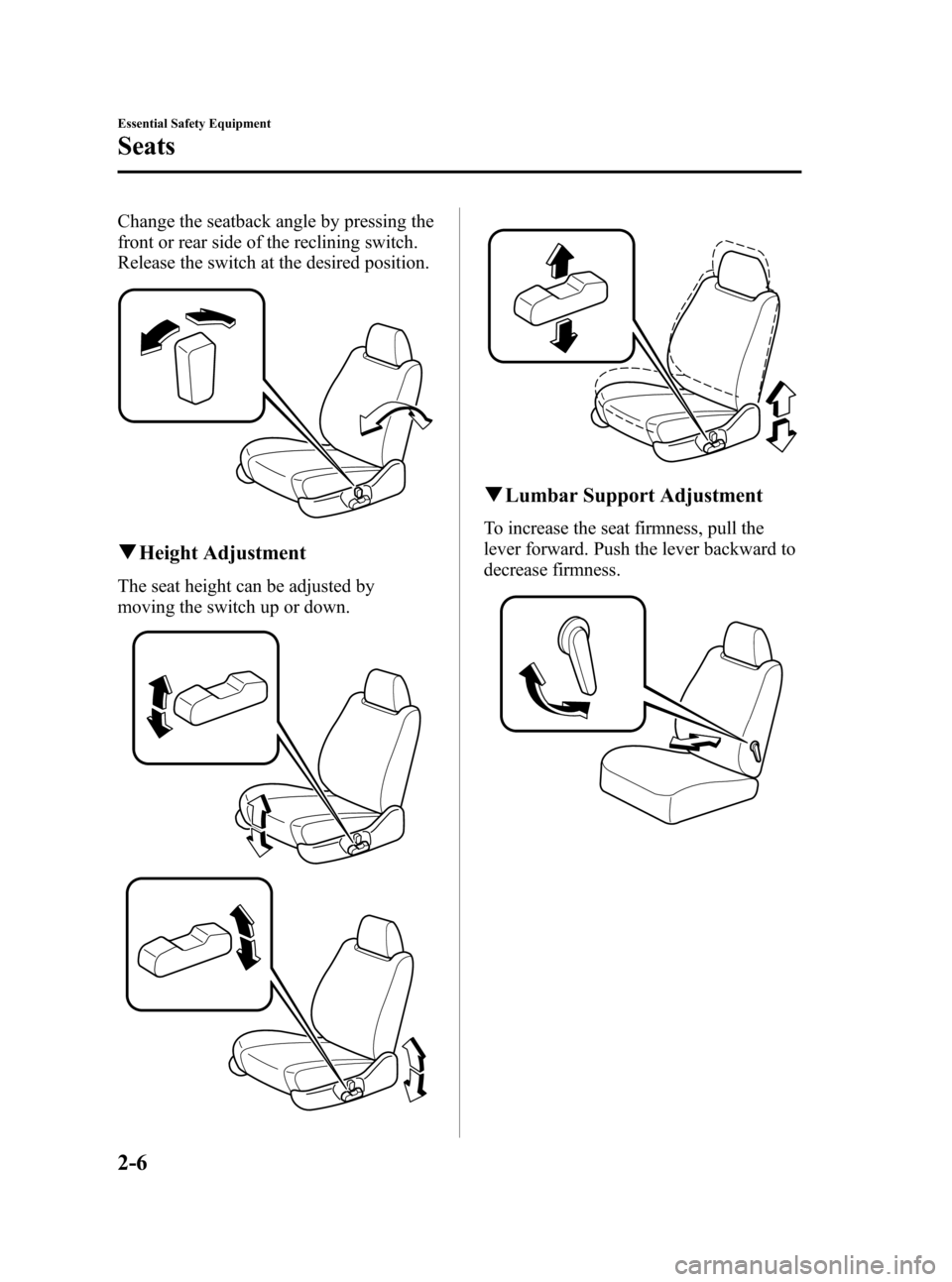
Black plate (18,1)
Change the seatback angle by pressing the
front or rear side of the reclining switch.
Release the switch at the desired position.
qHeight Adjustment
The seat height can be adjusted by
moving the switch up or down.
qLumbar Support Adjustment
To increase the seat firmness, pull the
lever forward. Push the lever backward to
decrease firmness.
2-6
Essential Safety Equipment
Seats
CX-7_8Z60-EA-08D_Edition2 Page18
Friday, May 30 2008 5:26 PM
Form No.8Z60-EA-08D
Page 22 of 454
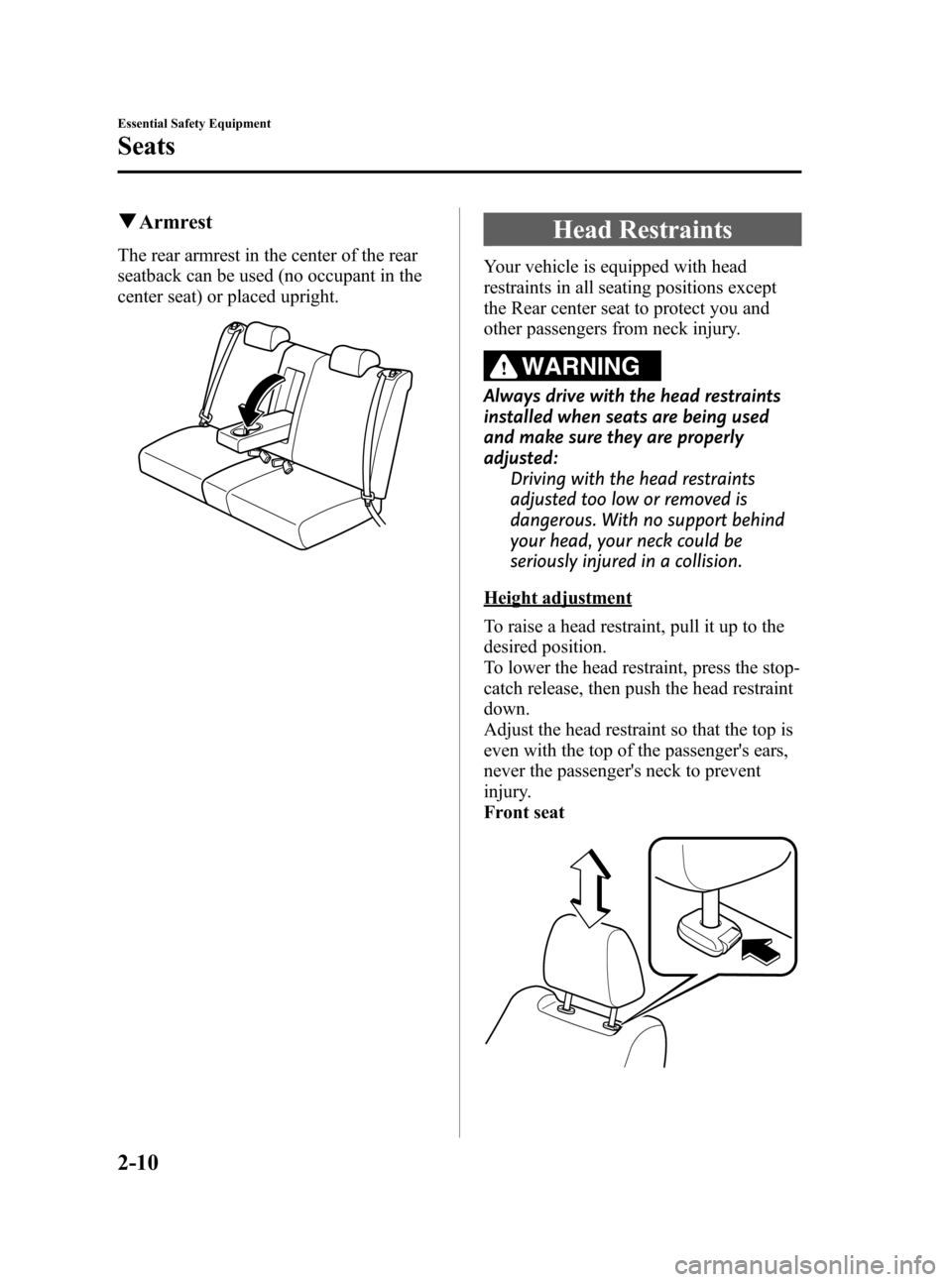
Black plate (22,1)
qArmrest
The rear armrest in the center of the rear
seatback can be used (no occupant in the
center seat) or placed upright.
Head Restraints
Your vehicle is equipped with head
restraints in all seating positions except
the Rear center seat to protect you and
other passengers from neck injury.
WARNING
Always drive with the head restraints
installed when seats are being used
and make sure they are properly
adjusted:
Driving with the head restraints
adjusted too low or removed is
dangerous. With no support behind
your head, your neck could be
seriously injured in a collision.
Height adjustment
To raise a head restraint, pull it up to the
desired position.
To lower the head restraint, press the stop-
catch release, then push the head restraint
down.
Adjust the head restraint so that the top is
even with the top of the passenger's ears,
never the passenger's neck to prevent
injury.
Front seat
2-10
Essential Safety Equipment
Seats
CX-7_8Z60-EA-08D_Edition2 Page22
Friday, May 30 2008 5:26 PM
Form No.8Z60-EA-08D
Page 30 of 454
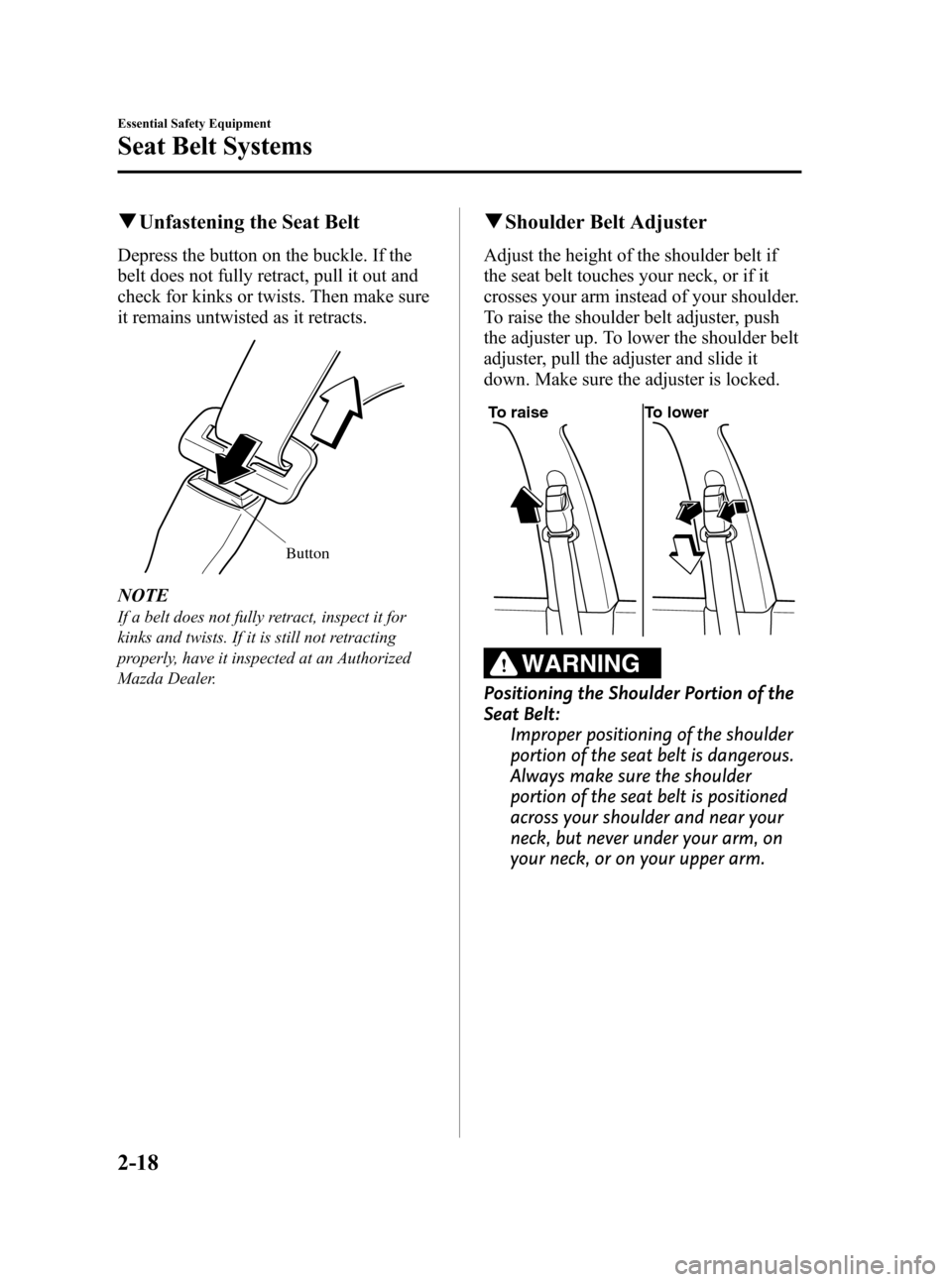
Black plate (30,1)
qUnfastening the Seat Belt
Depress the button on the buckle. If the
belt does not fully retract, pull it out and
check for kinks or twists. Then make sure
it remains untwisted as it retracts.
Button
NOTE
If a belt does not fully retract, inspect it for
kinks and twists. If it is still not retracting
properly, have it inspected at an Authorized
Mazda Dealer.
qShoulder Belt Adjuster
Adjust the height of the shoulder belt if
the seat belt touches your neck, or if it
crosses your arm instead of your shoulder.
To raise the shoulder belt adjuster, push
the adjuster up. To lower the shoulder belt
adjuster, pull the adjuster and slide it
down. Make sure the adjuster is locked.
To raise To lower
WARNING
Positioning the Shoulder Portion of the
Seat Belt:
Improper positioning of the shoulder
portion of the seat belt is dangerous.
Always make sure the shoulder
portion of the seat belt is positioned
across your shoulder and near your
neck, but never under your arm, on
your neck, or on your upper arm.
2-18
Essential Safety Equipment
Seat Belt Systems
CX-7_8Z60-EA-08D_Edition2 Page30
Friday, May 30 2008 5:26 PM
Form No.8Z60-EA-08D
Page 62 of 454
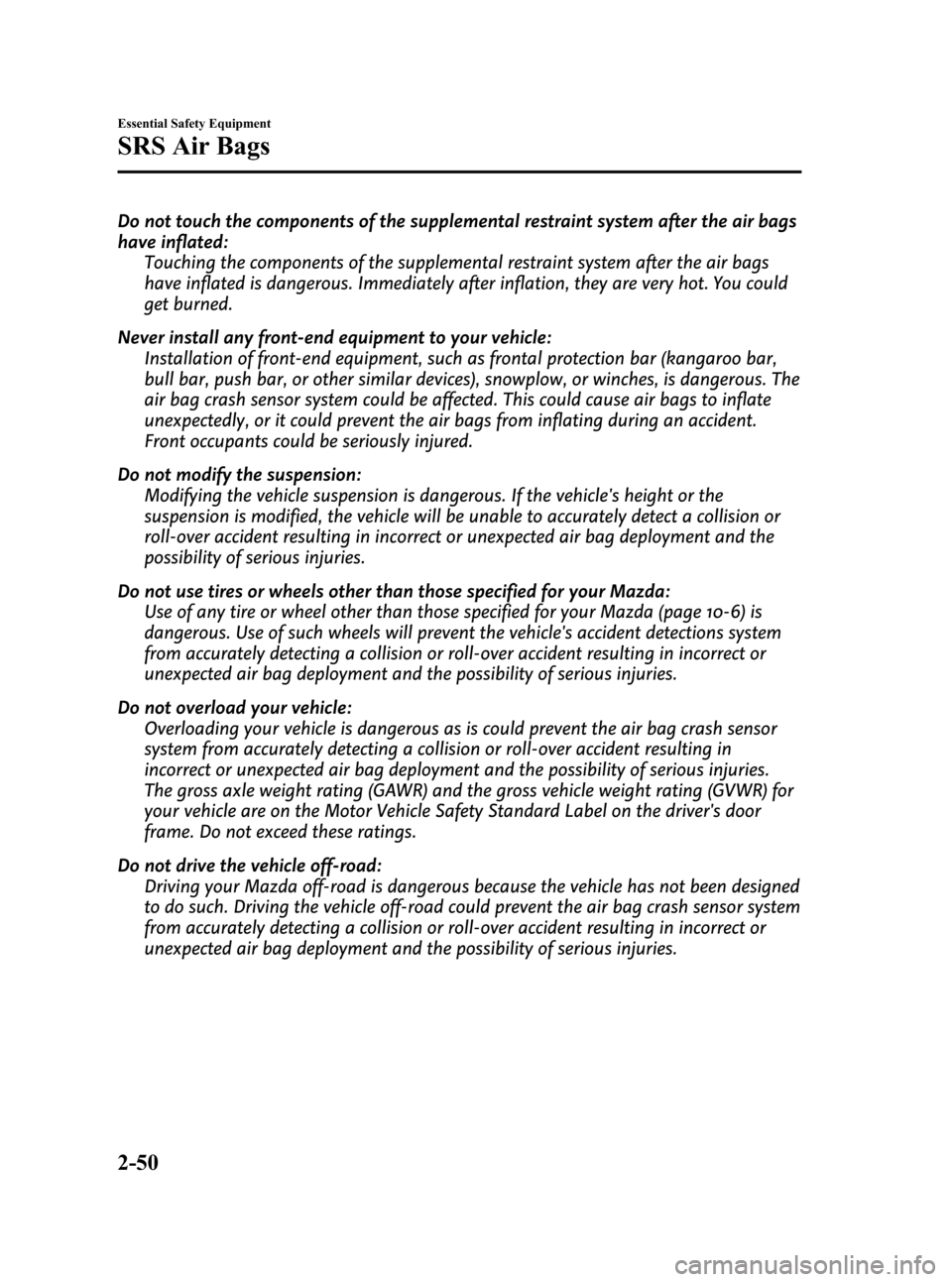
Black plate (62,1)
Do not touch the components of the supplemental restraint system after the air bags
have inflated:
Touching the components of the supplemental restraint system after the air bags
have inflated is dangerous. Immediately after inflation, they are very hot. You could
get burned.
Never install any front-end equipment to your vehicle:
Installation of front-end equipment, such as frontal protection bar (kangaroo bar,
bull bar, push bar, or other similar devices), snowplow, or winches, is dangerous. The
air bag crash sensor system could be affected. This could cause air bags to inflate
unexpectedly, or it could prevent the air bags from inflating during an accident.
Front occupants could be seriously injured.
Do not modify the suspension:
Modifying the vehicle suspension is dangerous. If the vehicle's height or the
suspension is modified, the vehicle will be unable to accurately detect a collision or
roll-over accident resulting in incorrect or unexpected air bag deployment and the
possibility of serious injuries.
Do not use tires or wheels other than those specified for your Mazda:
Use of any tire or wheel other than those specified for your Mazda (page 10-6) is
dangerous. Use of such wheels will prevent the vehicle's accident detections system
from accurately detecting a collision or roll-over accident resulting in incorrect or
unexpected air bag deployment and the possibility of serious injuries.
Do not overload your vehicle:
Overloading your vehicle is dangerous as is could prevent the air bag crash sensor
system from accurately detecting a collision or roll-over accident resulting in
incorrect or unexpected air bag deployment and the possibility of serious injuries.
The gross axle weight rating (GAWR) and the gross vehicle weight rating (GVWR) for
your vehicle are on the Motor Vehicle Safety Standard Label on the driver's door
frame. Do not exceed these ratings.
Do not drive the vehicle off-road:
Driving your Mazda off-road is dangerous because the vehicle has not been designed
to do such. Driving the vehicle off-road could prevent the air bag crash sensor system
from accurately detecting a collision or roll-over accident resulting in incorrect or
unexpected air bag deployment and the possibility of serious injuries.
2-50
Essential Safety Equipment
SRS Air Bags
CX-7_8Z60-EA-08D_Edition2 Page62
Friday, May 30 2008 5:26 PM
Form No.8Z60-EA-08D
Page 145 of 454
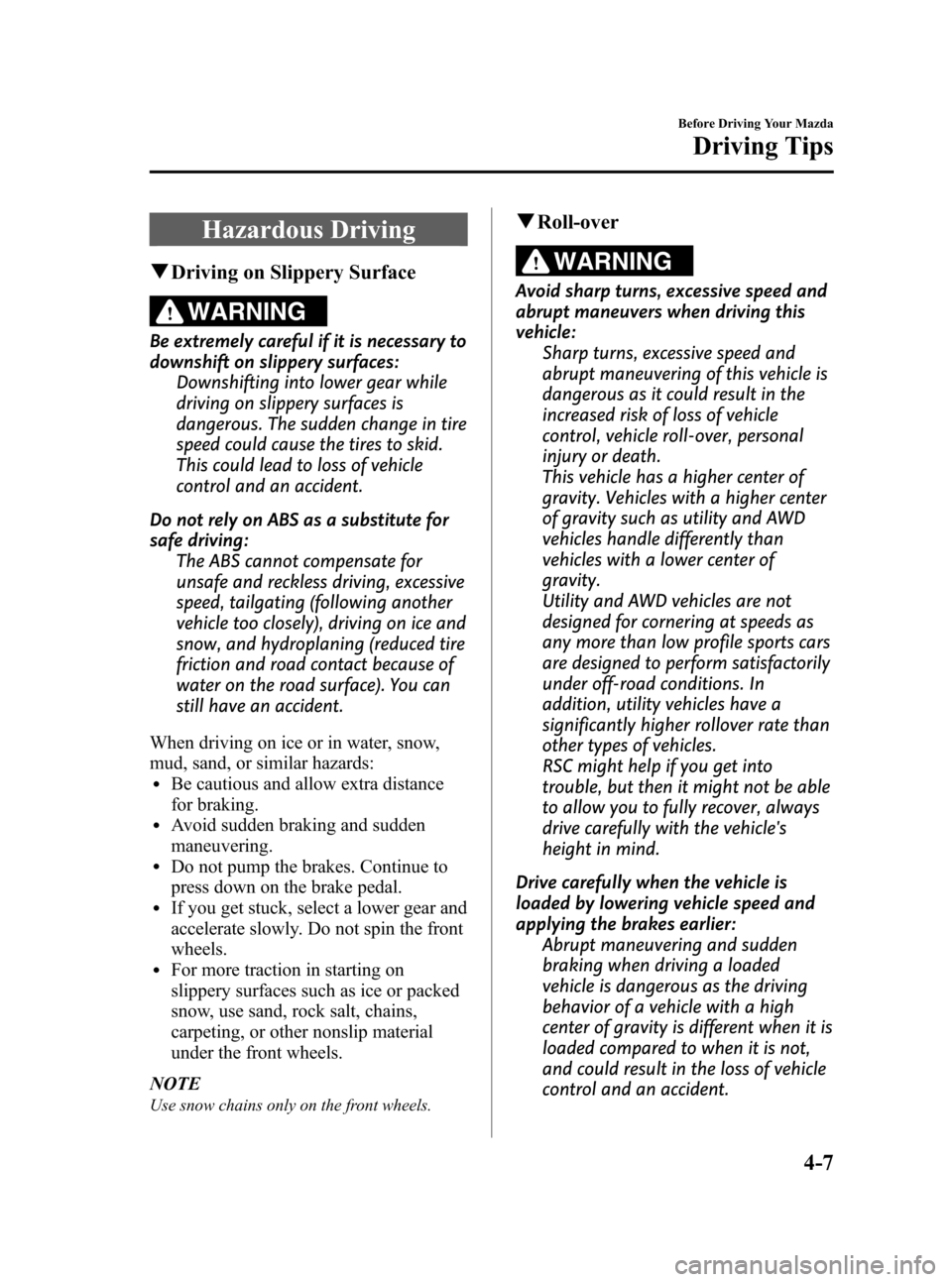
Black plate (145,1)
Hazardous Driving
qDriving on Slippery Surface
WARNING
Be extremely careful if it is necessary to
downshift on slippery surfaces:
Downshifting into lower gear while
driving on slippery surfaces is
dangerous. The sudden change in tire
speed could cause the tires to skid.
This could lead to loss of vehicle
control and an accident.
Do not rely on ABS as a substitute for
safe driving:
The ABS cannot compensate for
unsafe and reckless driving, excessive
speed, tailgating (following another
vehicle too closely), driving on ice and
snow, and hydroplaning (reduced tire
friction and road contact because of
water on the road surface). You can
still have an accident.
When driving on ice or in water, snow,
mud, sand, or similar hazards:
lBe cautious and allow extra distance
for braking.
lAvoid sudden braking and sudden
maneuvering.
lDo not pump the brakes. Continue to
press down on the brake pedal.
lIf you get stuck, select a lower gear and
accelerate slowly. Do not spin the front
wheels.
lFor more traction in starting on
slippery surfaces such as ice or packed
snow, use sand, rock salt, chains,
carpeting, or other nonslip material
under the front wheels.
NOTE
Use snow chains only on the front wheels.
qRoll-over
WARNING
Avoid sharp turns, excessive speed and
abrupt maneuvers when driving this
vehicle:
Sharp turns, excessive speed and
abrupt maneuvering of this vehicle is
dangerous as it could result in the
increased risk of loss of vehicle
control, vehicle roll-over, personal
injury or death.
This vehicle has a higher center of
gravity. Vehicles with a higher center
of gravity such as utility and AWD
vehicles handle differently than
vehicles with a lower center of
gravity.
Utility and AWD vehicles are not
designed for cornering at speeds as
any more than low profile sports cars
are designed to perform satisfactorily
under off-road conditions. In
addition, utility vehicles have a
significantly higher rollover rate than
other types of vehicles.
RSC might help if you get into
trouble, but then it might not be able
to allow you to fully recover, always
drive carefully with the vehicle's
height in mind.
Drive carefully when the vehicle is
loaded by lowering vehicle speed and
applying the brakes earlier:
Abrupt maneuvering and sudden
braking when driving a loaded
vehicle is dangerous as the driving
behavior of a vehicle with a high
center of gravity is different when it is
loaded compared to when it is not,
and could result in the loss of vehicle
control and an accident.
Before Driving Your Mazda
Driving Tips
4-7
CX-7_8Z60-EA-08D_Edition2 Page145
Friday, May 30 2008 5:27 PM
Form No.8Z60-EA-08D
Page 154 of 454

Black plate (154,1)
WARNING
Always make sure the trailer hitch is securely attached before departure:
An unsecured trailer hitch is dangerous as it causes greater trailer sway from
crosswinds, rough roads or other causes, resulting in loss of control and a serious
accident.
Examine all trailer-hitch mounting bolts regularly and tighten any that are loose. If
the hitch is removed, seal any open mounting holes to prevent exhaust, dust, water,
dirt and other foreign elements from filtering in, possibly endangering personal
safety and damaging your vehicle.
Do not install a hitch that stiffens the bumper as it will reduce the bumper's
performance.
Make sure there are no exhaust gas leaks into the passenger compartment if any
mounting bolts are connected to the body:
Modifying your vehicle exhaust system is dangerous. Exhaust gas entering the
vehicle could cause loss of consciousness or even death.
When mounting the trailer hitch, make no modifications to the vehicle exhaust
system.
CAUTION
ØMake all hitch adjustments with actual loads. Don't load and unload vehicle while
adjusting hitch. This action will change the vehicle height.
ØDon't use an axle-mounted hitch. This may damage the axle and related parts.
qTires
When towing a trailer, make sure all tires are inflated to the recommended cold-tire
pressure, as indicated on the tire pressure chart on the driver's door frame. Trailer tire size,
load rating, and inflation pressures should conform to tire manufacturer specifications.
WARNING
Never use the temporary spare tire when towing:
Using the temporary spare tire on your vehicle when towing a trailer is dangerous as
it could result in tire failure, loss of control, and injury to vehicle occupants.
4-16
Before Driving Your Mazda
Towing
CX-7_8Z60-EA-08D_Edition2 Page154
Friday, May 30 2008 5:27 PM
Form No.8Z60-EA-08D
Page 374 of 454

Black plate (374,1)
CAUTION
ØA wrong-sized wheel may
adversely affect:
ØTire fit
ØWheel and bearing life
ØGround clearance
ØSnow-chain clearance
ØSpeedometer calibration
ØHeadlight aim
ØBumper height
ØTire Pressure Monitoring
System
ØLimited-Slip Differential System
Ø(With Tire Pressure Monitoring
System)
ØWhen replacing/repairing the
tires or wheels or both, have the
work done by an Authorized
Mazda Dealer, or the tire
pressure sensors may be
damaged.
ØThe wheels equipped on your
Mazda are specially designed
for installation of the tire
pressure sensors. Do not use
non-genuine wheels, otherwise
it may not be possible to install
the tire pressure sensors.
NOTE
Be sure to install the tire pressure sensors
whenever tires or wheels are replaced. Refer to
Tires and Wheels on page 5-31.
When replacing a wheel, make sure the
new one is the same as the original factory
wheel in diameter, rim width, and offset.
Proper tire balancing provides the best
riding comfort and helps reduce tread
wear. Out-of-balance tires can cause
vibration and uneven wear, such as
cupping and flat spots.
8-38
Maintenance and Care
Owner Maintenance
CX-7_8Z60-EA-08D_Edition2 Page374
Friday, May 30 2008 5:29 PM
Form No.8Z60-EA-08D
Page 415 of 454

Black plate (415,1)
Tire Labeling
Federal law requires tire manufacturers to place standardized information on the sidewall of
all tires. This information identifies and describes the fundamental characteristics of the tire
and also provides a tire identification number for safety standard certification and in case of
a recall.
qInformation on Passenger Vehicle Tires
Please refer to the diagram below.
1. TIN: U.S. DOT tire identification number
2. Passenger car tire
3. Nominal width of tire in millimeters
4. Ratio of height to width (aspect ratio)
5. Radial
6. Rim diameter code
7. Load index & speed symbol
8. Severe snow conditions
9. Tire ply composition and materials used
10. Max. load rating
Customer Information and Reporting Safety Defects
Tire Information (except Canada)
9-23
CX-7_8Z60-EA-08D_Edition2 Page415
Friday, May 30 2008 5:29 PM
Form No.8Z60-EA-08D
Page 416 of 454

Black plate (416,1)
11. Tread wear, traction and temperature grades
12. Max. permissible inflation pressure
13. SAFETY WARNING
P215/65R15 95H is an example of a tire size and load index rating. Here is an explanation
of the various components of that tire size and load index rating. Note that the tire size and
load index rating may be different from the example.
P
Indicates a tire that may be installed on cars, SUVs, minivans and light trucks as designated
by the Tire and Rim Association (T&RA).
NOTE
If your tire size does not begin with a letter this may mean it is designated by either ETRTO
(European Tire and Rim Technical Organization) or JATMA (Japan Tire Manufacturing Association).
215
“215”is the nominal width of the tire in millimeters. This three-digit number gives the
width in millimeters of the tire from sidewall edge to sidewall edge. In general, the larger
the number, the wider the tire.
65
“65”is the aspect ratio. This two-digit number indicates the tire's ratio of height to width.
R
“R”is the tire construction symbol. R indicates“Radial ply construction”.
15
“15”is the wheel rim diameter in inches.
95
“95”is the Load Index. This two-or three-digit number indicates how much weight each
tire can support.
9-24
Customer Information and Reporting Safety Defects
Tire Information (except Canada)
CX-7_8Z60-EA-08D_Edition2 Page416
Friday, May 30 2008 5:29 PM
Form No.8Z60-EA-08D